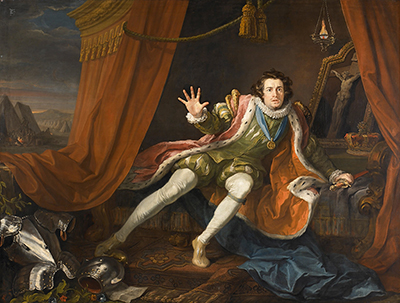Currently housed in the Walker Art Gallery at Liverpool, William Hogarth's painting David Garrick as Richard III was painted in 1845 and sits at the very heart of 18th century history and culture.
The painting shows David Garrick, one-time pupil of Dr Samuel Johnson, who rose to the height of his fame as a Shakespearean actor and theatre manager. It is for his role as Shakespeare’s Richard III that Garrick first caught wider public attention, with the Irish writer Arthur Murphy describing the strong impression the young Garrick made in that first performance: He made 'on the very first night, a deep impression on the audience. His fame ran through the metropolis. The public went in crowds to see a young performer, who came forth at once a complete master of his art'.
Though more widely known for his satirical drawings and wide-circulating prints, here Hogarth shows off his mastery of painting and portraiture. Garrick is shown in full costume amidst the lavish set design of the 18th Century theatre in one of Richard III’s most memorable scenes. In Act 5 Scene 3, on the night before the climactic Battle of Bosworth Field that will see the villainous Lancastrian king bought down by the Tudor invader Henry VII, Richard awakes from a dream in which a parade of his previous victims curse and chastise the King. The ghostly words of the murdered Duke of Buckingham ring in Richard's ears:
God and good angel fight on Richmond's side;
And Richard falls in height of all his pride.
Hogarth's painting masterfully captures Garrick's acting at this pivotal moment, poised in terror before the time of his defeat. At this point Richard embarks on a soliloquy, bemoaning his fear:
O coward conscience, how dost thou afflict me!
The lights burn blue. It is now dead midnight.
Cold fearful drops stand on my trembling flesh.
All the lavishness of the tent and royal costume cannot hide the plain fear in Richard's eyes, or the hopelessness of his situation, as he reaches for his sword with a pathetic start. In the top left corner of the painting the lavish foreground of the King’s tent gives way to a bare and long fading view of the army’s camp, suggesting the morrow’s grim outcome for the Lancastrian king.




